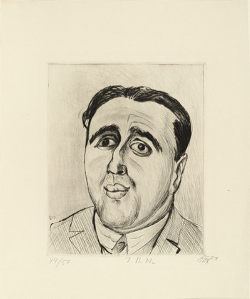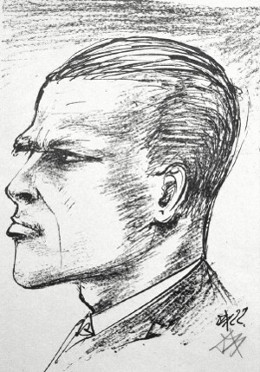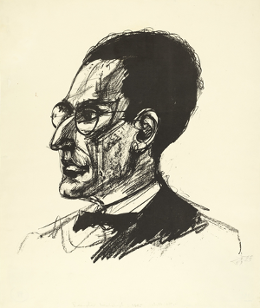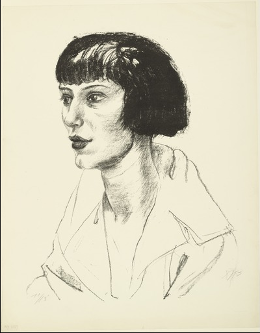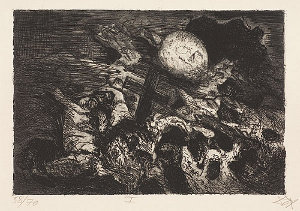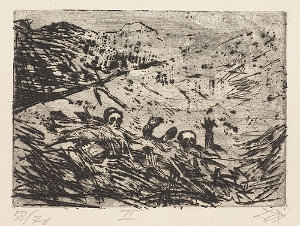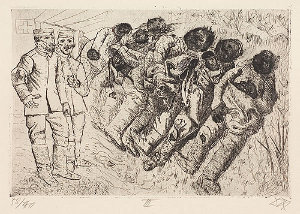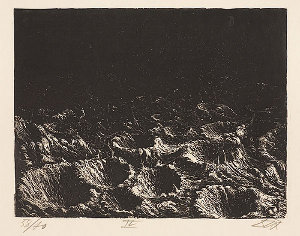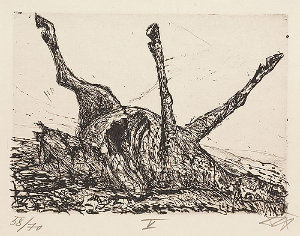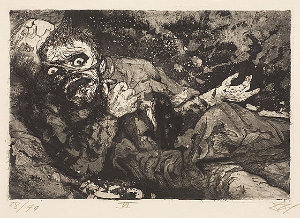J. B. Neumann
Year: 1922
Description: J. B. Neumann was an art dealer and connoisseur. In the early 1920s, he recognized Dix's talent and displayed his work in his German galleries. When he opened a New York gallery, Neumann introduced Dix to a new audience in the United States.
Dix showed his appreciation by portraying Neumann in a series of unflattering portraits.
Provenance: Museum of Modern Art
Self-Portrait in Profile
Selbstporträt im Profil
Year: 1922
Description: Dix's treatment of himself was always less harsh than his treatment of others. This work is typical. While Dix certainly accentuates some features at the expense of others, he stresses the most manly ones, a square jaw, a protruding ridge.
Certainly we can categorize this piece as cariacture, but it's a flattering portrait nonetheless.
Provenance: Private Collection
- Edition: 100
- Unnumbered
- Signed in plate and pencil
- Ref: Karsch, Florian
Portrait of Otto Klemperer
Year: 1923
Description: Otto Klemperer was a German conductor and composer. He was widely regarded as one of the leading composers of the 20th Century. His reputation may have spared him from the Dixian treatment. In this piece, he cuts an almost majectic image.
This piece was completed in 1923. At the time, Klemperer was working at the Cologne Opera House. It was his fourth major position since 1910.
American readers may know Otto Klemperer as the father of Werner, the American actor who played Colonel Klink on the sitcom Hogan's Heroes.
Provenance: Private Museum
- Museum of Modern Art, New York, NY
- From: Gertrud A. Mellon Fund
- Publisher: Karl Nierendorf, Berlin
Mrs. Otto Mueller
Frau Otto Mueller
Year: 1923
Description: Althugh much older than most of the Great War generation, the German Expressionist Otto Mueller served from 1916-1918. He was 42 when he reported for duty. After the war, Mueller moved to Breslau where he taught at the art akademie in what is today's Wrocław, Poland. He had strong ties to Dresden and frequently traveled the short distance to that city from Breslau. It was there that he and his wife probably met Dix.
Provenance: Public Museum
- Museum of Modern Art (126.1945)
- Karl Nierendorf, Berlin (1923)
Soldier's grave between the lines
Soldatengrab zwischen den Linien
Year: 1924
Description: This is the first plate from Dix's series about the Great War. It was called The War and it was modelled on Goya's The Disasters of War devoted to the Spanish War of Independence. Dix opens the series with a reflection on the First rule of battle: Young men die in war.
Provenance: Der Krieg; #1
National Gallery of Austrailia
Canberra
Buried alive - January 1916, Champagne
Verschuttete - Januar 1916, Champagne
Year: 1924
Description: The series opened with a soldier's grave between the lines. The second plate provides a graphic depiction of how such graves are produced. Soldiers react in horror as the earth collapes around them. In the instant before they are swallowed, Dix depicts them not as they are but as they will become. Their faces are reduced to depictions of skulls.
Provenance: Der Krieg; #2
National Gallery of Austrailia
Canberra
Gas victims - Templeux-la-Fosse, August 1916
Gastote - Templeux-la-Fosse, August 1916
Year: 1924
Description: By 1924, the audience aware of the horrors of gas but censored wartime reporting spared many from its ghastly details. Here the results are depicted with raw clarity of someone who was there. Indeed, much of Der Krieg was based on Dix's wartime diary drawings. Many were probably struck by the appearance of the victims, darkened for lack of oxygen and the nonchallance of the medical staff who had seen it many times before.
Provenance: Der Krieg; #3
National Gallery of Austrailia
Canberra
Crater field near Dontrien lit up by flares
Trichterfeld bei Dontrien, von Leuchtkugeln erhellt
Year: 1924
Description: Already by plate number four we begin to understand this is no ordinary series of etchings. Throughout the series, Dix demonstrates a commanding use of print techniques with etching, dry point and aquatint. Here a night time flare illuminates a lunar landscape.
Provenance: Der Krieg; #4
National Gallery of Austrailia
Canberra
Corpse of a horse
Pferdekadaver
Year: 1924
Description: It is said that men often go into battle with a plan to fight the previous war. Great War combatants on both sides held on to the notion of a great cavalry charge that would stem tide. Horsemen never had a chance to prove their daring on the Western Front. The nature of warfare had changed dramatically since the Franco-Prussian war.
Armies became entrenched and cavalries were held in reserve but that didn't mean horses were immune to savagery. Work animals still moved men and material to the front. The war indiscriminately destroyed anything in its path.
Provenance: Der Krieg; #5
National Gallery of Austrailia
Canberra
Wounded soldier - Autumn 1916, Bapaume
Verwundeter - Herbst 1916, Bapaume
Year: 1924
Description: Bapaume was hotly contested in 1871. In the fall of 1916, it was an Allied objective during the Battle of the Somme. In the Second World War, armies would battle there once again. Dix survived but the images of wounded men haunted him.
Provenance: Der Krieg; #6
National Gallery of Austrailia
Canberra
